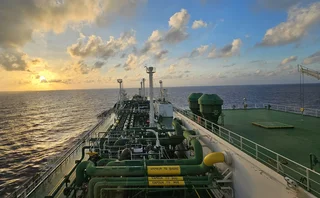Coal house of the year, Asia: Tata International Singapore
Energy Risk Asia awards, 2018: Vietnamese deal puts Tata International Singapore on the map

For Tata International Singapore (TIS), it was the deal that showed they had arrived: in 2017, it became the first international company to win a contract to supply thermal coal to EVN, Vietnam’s state-owned electricity monopoly.
“It helped put us on the map internationally,” says Singapore-based Sabyasachi Mishra, global head of sales. It also demonstrated the capability of Tata’s still youthful trading arm with the initial deal – a supply contract for 1.2 million tonnes that covered some four months of EVN’s requirements – being followed by two more supply contracts that brought the total volume to three million tonnes.
The unit was launched, with Mishra as the first employee, in late 2011 in recognition of the risks that India’s giant Tata group was running as a large consumer of coal and other minerals – as well the opportunities presented in providing trading and risk management services to its customers.
“We appreciated that we’d come late, and that a lot of other trading entities had been formed by that time, but we thought that with the size of the parent business, and the trust element [associated with the Tata name], there could be a growth story,” says Mishra.
Just seven years later, TIS has expanded into a 50-strong team, based largely in Singapore and India but with sales and origination offices in Indonesia, China, South Africa and Vietnam, and with a turnover in excess of 10 million tonnes of coal a year.
The initial EVN transaction is illustrative of some of the challenges faced by coal traders such as TIS. The biggest issue was the shallow port at EVN’s DH3 power plant, meaning that the coal had to be transferred from a larger vessel offshore onto smaller barges. “That was the first time we had carried out such a transshipment operation – it was a considerable logistical challenge.”
In addition, TIS faced some price risk on the trades, given that it tends to buy coal at fixed prices, while the tender is based on the globalCOAL NEWC Index, which provides a benchmark price for seaborne thermal coal in the Asia-Pacific.
We appreciated that we’d come late, and that a lot of other trading entities had been formed by that time, but we thought that with the size of the parent business, and the trust element [associated with the Tata name], there could be a growth story
Sabyasachi Mishra, Tata International Singapore
“Compared to other commodity derivatives markets, coal is considerably less liquid,” notes Mishra, estimating that the notional size of the derivatives market is roughly equal to the physical, in contrast to Brent crude or West Texas Intermediate crude oil derivatives, for example, where this ratio is around 100-to-one. “We do face challenges to cover our positions, particularly when we’re trying to cover a large quantity: we may have to pace it out over a few days. We’re definitely taking on some risk there.”
However, as the market matures, “the tools are becoming more and more available”, he adds, noting that the recent introduction of the ICI 4 weekly assessment – produced by Argus and Coalindo Energy to track Indonesian physical coal prices – has facilitated an over-the-counter swap market for Indonesian coal.
“Newcastle, API 4 [which references the price of coal exported from Richards Bay, South Africa] and now ICI 4 are the three main swaps in which we dabble – they represent the main locations where we have most of our ontakes.”
However, basis risk is a fact of life in the coal market, as Mishra adds: “Fundamentally, you have to build it into your margins.”
Similarly, shipping represents a major risk, particularly given recent volatility in oil prices. However, TIS is able to rely to a large extent on sister shipping companies within the Tata group. “They take care of the volatility but, as we grow bigger, it’s an area where we would like to take positions in terms of time or period charters, and we’d have to look to hedge some of those risks.”
Mishra adds that one of TIS’s strengths is the unusual ability to provide clients with risk management services, for example around price risk. “We give the client the option to give us a call and we’ll give him a number at which he can switch to a fixed price.”
Of course, as the world increasingly acknowledges the risks of climate change, question marks hang over the future of coal for power generation. “We recognise there are negatives around coal in terms of long-term planning,” says Mishra. “We are working to expand our portfolio beyond thermal coal, into base metals, steel raw materials, and we see a growing need for coking coal used in steel production,” he says.
“But on the [thermal] coal side, we do continue to see an immediate need for coal for baseload power for the next 10 years or so, before green energy takes charge. Beyond 10 years, we need to look at alternative products.”
More on Risk management
LNG trading strategies set to change amid major market shifts
The global LNG market is on the brink of significant changes set to alter trading dynamics and market behaviour, say analysts
Why commodity finance is ripe for stablecoin
Digital currency brings cost efficiencies to financing, but its real benefit to commodity firms lies in making huge pools of new capital available, write Jean-Marc Bonnefous and Ronan Julien
US shutdown leaves commodity traders without key data
Commodity traders are ‘flying blind’ without Commitment of Traders reports
Energy Risk at 30: Learning from the past
Energy Risk looks back at the seminal events and developments that have shaped today’s energy markets
Past disasters can prove the value of energy risk management
Analysing failures and losses at energy firms can underscore the value of consistent, high-quality risk management
How quants shaped the modern energy markets
The business models of today’s utility firms are built on quantitative analysis, but the introduction of these techniques in the 1990s was far from smooth
Interview: Vince Kaminski
Market veteran Vince Kaminski discusses the biggest risks to energy firms today and whether risk teams can ever prove their value
Mounting risk prompts refocus on integrated energy risk management
Energy firms are facing heightened risk due to shifting geopolitics, climate change and the energy transition. As market, credit and enterprise risks ramp up, the need for improved integrated risk management is growing, say risk managers








